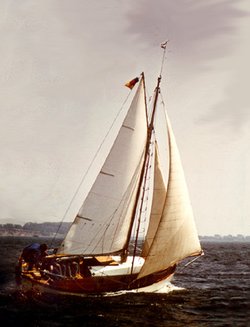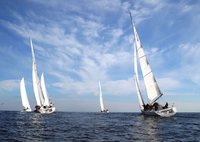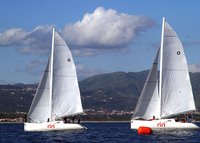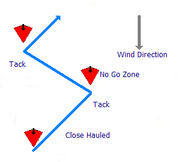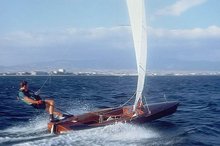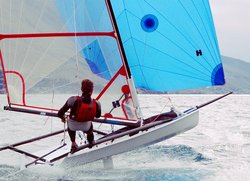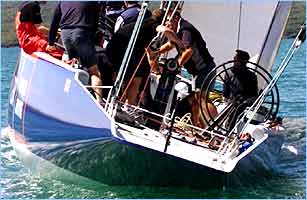|
SAILS and SAILING BOATS
|
|
A sail is a large piece of cloth on the top of some boats. The wind pushes against the sail and makes the boat move. The piece that the sail is attached to is called a mast. Some boats have many sails and some have only one. Usually small boats have only one sail and bigger boats have more. Boats with sails are usually called sailboats.
There are also many different names for different kinds of sailboats with different kinds of sails. Before people made boats with engines that used coal or oil, sailboats were an important way to travel across oceans. Now they are not so important, but sometimes they are used for recreation.
Sailing using the wind is clean and environmentally friendly. A lot of skill and manpower is required to properly operate a sailing vessel. Solar Navigator uses energy from the Sun directly converting it into electricity, before the radiant energy is converted into the cooling winds which distribute heat around our planet. Instead of sails made of cloth, Solar Navigator has wings surfaced with photovoltaic cells arranged in panels. Instead of catching the wind, this revolutionary craft catches light.
A traditional wooden sailing boat
Hence, a sail is a surface intended to generate thrust by being placed in a wind. Depending on the incident angle of the wind on the surface of the sail, one side of the sail will have a higher air pressure than the other one according to Bernoulli's principle.
The difference in pressure will generate lift, causing the sail to be pulled towards the side of lower pressure. On a sailing boat, a keel or centreboard is used to convert this lateral force into forward movement of the boat with some sideways leaning, or ' heel '. Sails are primarily used at sea, on sailing ships as a propulsion system. For purposes of commerce, sails have been largely superceded by other forms of propulsion, such as the internal combustion engine. For recreation, however, sailing vessels remain popular.
The most familiar type of sailboat, a small pleasure yacht, usually has a sail-plan called a sloop. This has two fore-and-aft sails: the mainsail and the jib. The mainsail extends aftward and is secured the whole length of its edges to the mast and to a boom also hung from the mast. The sails of tall ships are attached to wooden timbers or " spars ". The jib is secured along its luff to a forestay (strong wire) strung from the top of the mast to the bowsprit on the bow (nose) of the boat.
Fore-and-aft sails can be switched from one side of the boat to the other, in order to alter the boat's course. When the boat's stern crosses the wind, this is called jibing ; when the bow crosses the wind, it is called tacking. Tacking repeatedly from port to starboard and/or vice versa, called "beating", is done in order to allow the boat to follow a course into the wind.
Sailing is motion across a body of water in a sailing ship, or smaller boat, powered by wind.
HOW SAILING WORKS
The force of the wind is used to create motion by using one or more sails. The movement of air over the sails acts in the same way as air moving over an aircraft's wing. Just like on an airplane, air flowing over the sail is deflected and accelerated. This generates lift, which acts to pull the sail, and thus the boat ahead, but also slightly downwind.
The downwind component is offset by an underwater hydrofoil (centerboard or keel), whose shape resists lateral movement while offering little resistance to forward motion. Without a keel or centerboard, sailing upwind or across the wind would be virtually impossible. (Other sailing hydrofoils include daggerboards and leeboards).
The lifting force of the sails also acts to lean the boat over to one side, which is called heeling. This is counteracted by ballast, either in the form of dense material located in the keel (usually lead or iron) or in the form of human or water ballast located near the windward rail.
U.S. Sailing team at the World Military Games sailing competition
BASIC SAILING TECHNIQUES
First see the notes on points of sail which introduce some important principles.
Turning a sailing boat
There are four basic maneuvers a sailing boat can perform while underway. They are:
TRIM
An important aspect of sailing is keeping the boat in "trim". To achieve this a useful mnemonic (memory aid) is the phrase. Can This Boat Sail Correctly? This helps the crew to remember these essential points;
Beating an upwind course
Using a series of close hauled legs to beat a course upwind
A basic rule of sailing is that it is not possible to sail directly into the direction the wind is coming from. Generally a cruising boat can sail 45 degrees off the wind, a racing boat may aproach 35 degrees. However since it is often necessary to move towards the wind direction, it is necessary to 'beat' upwind.
Beating, is simply a series of 'tacks' where the boat sails as close to the wind on each tack as possible, and then switch sides and repeate the process. By this method, it is possible to travel directly into the wind.
Reducing sail
An important safety aspect of sailing is to adjust the amount of sail to suit the wind conditions. As the wind speed increases the crew should progressively reduce the amount of sail. On a small boat with only jib and mainsail this is done by furling the jib and by partially lowering the mainsail, a process called 'reefing the main'.
Reefing basically means reducing the size of a sail without changing them. Ideally reefing does not only result in a reduced sail area but also in a lower center of effort from the sails, keeping the boat more upright.
There are three core methods of reefing the mainsail: - Slab reefing, which involves lowering the sail by about one-quarter to one-third of its luff length and tightening the lower part of the sail using an outhaul through a cringle at the new clew, and hook through a cringle at the new tack. - In-mast (or on-mast) roller-reefing. This method rolls the sail up around a vertical foil either inside a slot in the mast, or affixed to the outside of the mast. It requires a mainsail with either no battens, or newly-developed vertical battens. - In-boom roller-reefing, with a horizontal foil inside the boom. This method allows for standard- or full-length horizontal battens.
Mainsail furling systems have become increasingly popular on cruising yachts as they can be operated shorthanded and from the cockpit in most cases, however, the sail can become jammed in the mast or boom slot if not operated correctly. Mainsail furling is almost never used while racing because it results in a less efficient sail profile. The classical slab-reefing method is the most widely used. Mainsail furling has an additional disadvantage in that its complicated gear may somewhat increase weight aloft. However, as the size of the boat increases, the benefits of mainsail roller furling increase dramatically.
Sail trimming
As noted above, sail trimming is a large subject. Basic control of the mainsail consists of setting the sail so that it is at an optimum angle to the wind,(i.e. no flapping at the front, and tell tales flowing evenly off the rear of the sail).
A Contender dinghy on a reach
Two or more sails are frequently combined to maximise the smooth flow of air. The sails are adjusted to create a smooth laminar flow over the sail surfaces. This is called the "slot effect". The combined sails fit into an imaginary aerofoil outline, so that the most forward sails are more in line with the wind, whereas the more aft sails are more in line with the course followed. The combined efficiency of this sail plan is greater than the sum of each sail used in isolation.
More detailed aspects include specific control of the sail's shape, e.g.:
See this detailed information on the quest for the perfect sail shape (http://www.wb-sails.fi/news/98_11_PerfectShape/Main.htm) and then try it out for yourself. (http://www.wb-sails.fi/news/SailTrimSim/TrimSimFrames.htm)
Heeling
When a boat rolls over to one side under wind pressure, it's called 'heeling'. As a sailing boat heels over beyond a certain angle, it begins to sail increasingly inefficiently. Several forces can counteract this movement.
Most of the above effects can be used to right a heeling boat and to keep the boat sailing efficiently: if however the boat heels beyond a certain point of stability, it can capsize.
Sailing close to the wind
How close a boat can sail to the wind depends on the wind speed, since what the boat "sees" is the apparent wind, i.e., the vector sum of the actual wind and the boat's own velocity. The apparent wind is what the windex on top of the mast shows. Because of this, people often talk about how close a boat can sail to the apparent wind. A good, modern sloop can sail within 25 degrees of the apparent wind. An America's Cup racing sloop can sail within 16 degrees, under the right conditions. Those figures might translate into 45 degrees and 36 degrees relative to the actual wind. The angles at which the wind meets the boat are described by the points of sail.
Sailing safety
First and foremost:
Sailing is intrinsically dangerous, since water is not our natural element. All sailors therefore should take precautions, and when engaged in publicly organised activities they must take certain precautions, as detailed by the authority which regulates the training or racing. Safety measures include:
Also, know the 'rules of the road':
Sailing hulls and hull shapes
Sailing boats can have one, two, or three hulls. Boats with one hull are known as monohulls, while those with two or more are known as multihulls. Multihulls can be further subdivided into catamarans (two hulls), and trimarans (three hulls). A sailing boat is turned by a rudder which itself is controlled by a tiller or a wheel. Smaller sailing boats often have a stabilising, raisable, underwater fin called a centreboard (or daggerboard); larger sailing boats have a fixed (or sometimes canting) keel. As a general rule, the former are called dinghies, the latter yachts.
A Musto Skiff
Types of Sails and layouts
On a modern yacht, the mainsail or main is usually the primary driving sail, triangular in shape, and fixed to the largest (or often the only) mast. A headsail, either a jib or genoa, is set in front of the mainsail, attached in such a way that the trailing edge extends back alongside the main. This is also known as an overlapping headsail (pronounced hedsal). Two or more headsails can be used. In addition, some sailboats, ketches and yawls, have another smaller mast called the mizzen mast, on which is set a smaller sail similar to the mainsail and called the mizzen sail.
A spinnaker is a large, full-bellied sail that is only used when sailing downwind, to catch the maximum amount of wind. See also Sail and sail-plan.
Sailing terminology
Sailors use many traditional nautical terms for the parts of or directions on a vessel; starboard (right), port (left), forward or fore (front), aft (rearward), bow (forward part of the hull), stern (aft part of the hull). Vertical spars are masts, horizontal spars are booms (if they can hit you), gaffs (if they're too high to reach) or poles (if they can't hit you).
Too many ropes!
Actually, only a few of the "ropes" on a boat are called ropes. Ropes or wires that hold up masts are collectively known as standing rigging and are called shrouds or stays (the stay connecting the top of the mast to the bow is called the forestay or headstay).
Ropes or wires that control the sails are known collectively as running rigging. Those that raise and lower sails are called halyards. Ropes that adjust (trim) the sails are called sheets. These are often referred to using the name of the sail they control (eg. "main sheet", or "jib sheet").
Ropes used to tie the boat up when alongside are called docklines. There are some ropes: A few examples, the bell rope (to ring the bell), a bolt rope (attached to the edge of a sail for extra strength), a foot rope (on old square riggers for the sailors to stand on while reefing or furling the sails), and a tiller rope (to temporarily hold the tiller and keep the boat on course). A rode is what keeps an anchor attached to the boat when the anchor is in use.
Other terms
Walls are called 'bulkheads'. The toilet is traditionally called the 'head', the kitchen is the 'galley'. Sails in different sail plans have unchanging names, however. For the naming of sails, see sail-plan.
Sailing terms have entered popular language in many ways. "Broken up" was the fate of a ship that hit a "rocky point." "Pooped" refers to the aftermost deck of a ship, taken from "puppis" the Latin word for "stern". "In the doldrums" referred to being becalmed, windless, especially in the narrow band of hot windless water "the doldrums", near the equator. "Adrift" meant literally that a ship's anchor had come loose, and the ship was out of control near land and therefore in serious danger. "Keel-hauled and hung out to dry." was the rather nasty process of attaching a sailor to a rope, and drawing him under the sailboat while underway, and then hanging him from a yard-arm (under his shoulders usually, not by his neck), where officers and crew could mock him. This was a particularly unpleasant punishment; apart from the risk of drowning, the sailor would be lacerated by the barnacles on the ship's hull.
Sailing regulations
Sailors are expected to know the essentials of boating safety which include;
Sailing traditions and etiquette
There are many, more esoteric, etiquette rules, traditions, and customs that will demonstrate to others advanced knowledge of boating protocol such as; pulling up the fenders when you're not in port, the use of flags. External links
SOLAR SAILS
This type of sail is not for use on boats, but could be useful for deep space travel one day. A Solar Sail deploys a large, lightweight sail which reflects solar radiation. The "light pressure" on the sail provides thrust by reflecting photons. Tilting the sail at an angle from the sun can produce a thrust component perpendicular to the angle between the sun and the spacecraft. Steering is usually with auxiliary vanes.
A number of demonstration projects have proven this method's feasibility. On a smaller scale, some unmanned spacecraft have been constructed with reflective panels that can be used to steer the spacecraft, to conserve fuel for maneuvering and attitude control. Solar collectors or sun shades can also serve as crude solar sails, and can help a spacecraft correct its orbit without using fuel.
It has also been proposed to use lasers to push solar sails. Given a sufficiently powerful laser and a large enough mirror to keep the laser focussed on the sail for long enough, a solar sail could be accelerated to a significant fraction of the speed of light. To do so, however, would require the engineering of massive, precisely-shaped optical mirrors (wider than the Earth for interstellar transport), incredibly powerful lasers, and more power for the lasers than humanity currently generates. (If you are at school: Ask your teacher about anything you are not clear on. Make the most of your time at school to find out about subjects that interest you. If you would like to follow our project more closely, why not join our club. We welcome your comment on technical subjects)
STERN and LINKS TO OTHER BOAT PARTS
STERN
Only the windward runners are tensioned and the higher the wind, the more they are tensioned.
During manoeuvres the new windward runner must be tensioned while the new leeward runner is slackened off. The wires – which hold a load of up to four tons - run through a block to the runner winch.
GBR Challenge in action videos : Modem or Broadband
Boat specifications >> Crew | Bow | Deck layout | Hull | Keel | Mast | Sails | Stern
LINKS
How Sails Really Work Arvel Gentry was largely responsible for delineating the modern theory of Sails. Quoted extensively by Marchaj and others this is his website. Includes articles on how sails really work and the implications for design and trim. Sailing and the Tech Dinghy -- MIT's dinghy sailing instruction booklet Sailing Simulator from National Geographic International Sailing Federation Quest for the perfect sail shape Online glossary of sailing terms Peter Lester NZ sailing commentator Sail Power Calculation Web Page
Healthier alternative tastes for adventure capitalists
Solar Red | Solar Crush | Solar Cola | Solar Spice | Solar +
|
|
This website is Copyright © 1999 & 2021. The bird logos and name Solar Navigator are trademarks. All rights reserved. All other trademarks are hereby acknowledged. Max Energy Limited is an educational charity. |
